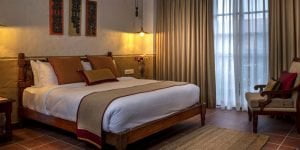Mera Peak &
Island Peak - Nepal
26 Days 6400 ex Kathmandu
Accommodation
3 Nights Hotel Stay
5 Nights Tent
17 Nights Tea House

Transportation
Mostly on foot
Transfers and domestic flights included
1 Porter 1 Trekker Policy

Included Meals
24 Breakfasts
22 Lunches
23 Dinners
All Open Menu Your Choice
Trip Grade
Category 4
Extreme Expedition – Cold

Group Size
2 – 8 Maximum
My crampons bit into the solid ice slope. Testing them, making sure they had traction, I pushed myself up, using my entire body to straighten my left knee so I was half a metre closer to the summit.
The air was cold and my hands even colder. My breathing was deep. I could see every breathe as I hoisted my way toward the icey dome above.
Over my shoulder, I could see the horizon start to glow a light blue. The sun was coming and night would soon be day.
It was at this point I began to get nervous. I could now see my surroundings and the height at which we stood. Still, the summit beckoned, so I kept my head down and continued the climb, one slow step at a time.
Reaching the pinnacle, I looked around and saw the most beautiful mountain range I’d ever witnessed. Jagged ridgelines sawed their away across the horizon. Glaciers spilled down every slope. There was a quiet in the world and a quiet in me, that I’m not certain I’d ever before experienced.
Incredibly, this was the second ethereal morning we’d experienced in less than a week! From above 6,000 metres, the world looks so small, as does my place feel within it…
Unsurpassed views of the Himalayas with Everest (8848m), Cho-Oyu (8201m), Lhotse (8516m), Makalu (8463m), Kanchenjunga (8586m) as well as Nuptse (7855m) and Chamlang (7319m) visible.
“Absolutely fantastic trip to the summit of Mera Central. All credit to the handsome Nima and his brilliant team of guides, cooks, and porters. Support from arrival to departure was superb. Highly recommended and hope to visit and climb again.”
Nick – UK
Two for the price of one!
Our Mera and Island Peak climbing itineraries have been carefully crafted to ensure you receive proper acclimatisation along the journey, and you receive proper climbing training before you ascend the summits. We use longer and less trodden trails with gradual ascents to ensure proper acclimatisation, away from any crowds. With over 14 years of designing trips to both peaks, we are confident you will be given every chance to reach her summit.
Part of our strategy is to set up our high camps at about 5800m (for Mera Peak) and 6100m (for Island Peak) respectively. In this way, we will have a shorter summit attempt. The Mera High camp is established on a rocky outcrop, protected from the elements by a large vertical wall. For Island Peak, we allow a full days rest to allow our bodies to adjust to the elevation, and allow our limbs to relax ahead of the final push to the summit.
Both summit days starts early in the morning and we approach the Mera Peak summit via the northern route – which involves a gradual climb with outstanding mountain panoramas. For Island Peak, we follow a steep ridge line towards the exposed traverse. The final ascent takes you along the vertical section. We’ll utilise fixed ropes and crampons on such steep parts.
We stay in the full-supported tented camps with EXPED down-filled mattresses, for extra comfort. As a safety precaution, we always carry a Portable Altitude Chamber (PAC) and Oxygen along with a comprehensive medical kit and a satellite phone for communication in case of emergency so you can be completely confident that your safety and comfort are our priorities. We provide all the personal and group climbing gears including LA-SPORTIVA’s Nepal Extreme climbing boots to make your trip to Mera Peak hassle-free and cost-effective.
So what are you waiting for? You have always wanted to try mountaineering. Mera Peak is a great summit to start your journey.

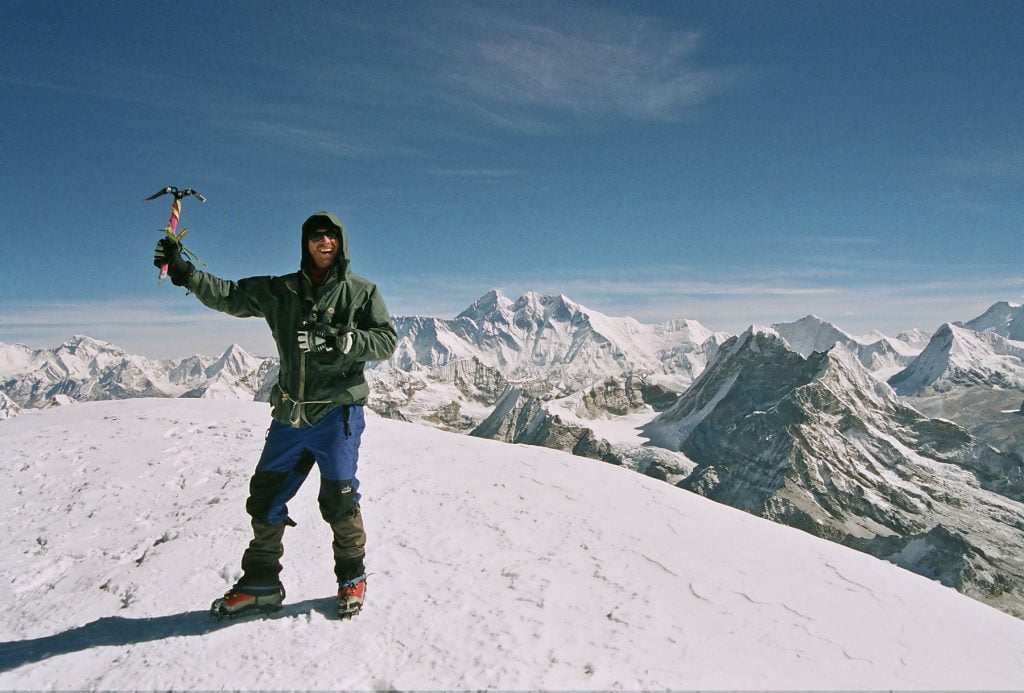
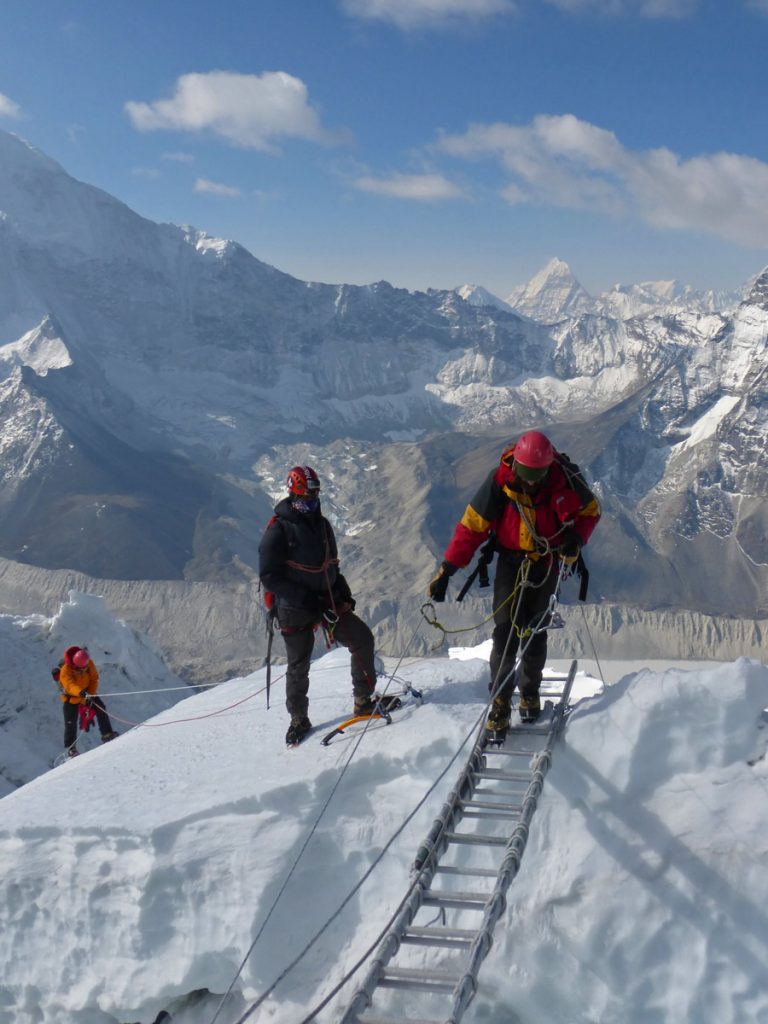
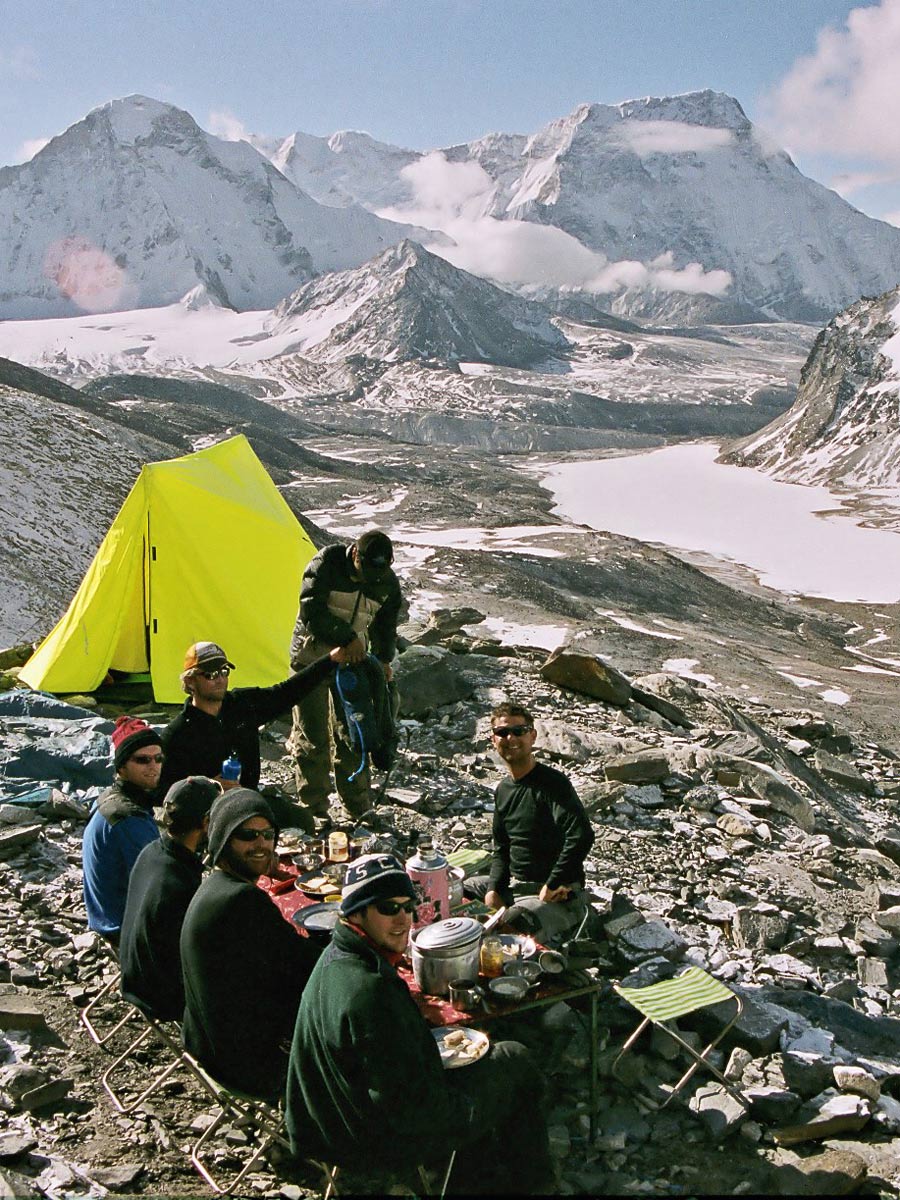
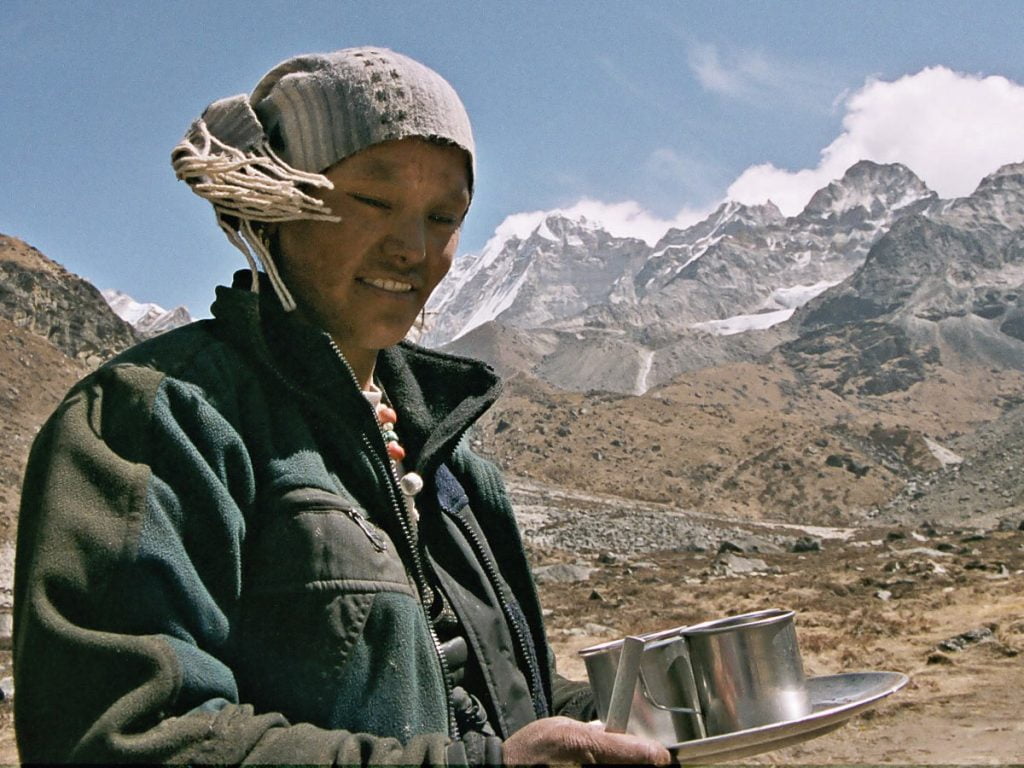
The Journey
Your group leader will meet you at the airport and take you to your hotel where you can relax, meet your teammates and take a stroll through Kathmandu’s bustling streets. We’ll enjoy a traditional Nepali dinner together and watch a cultural performance before getting much needed rest. (D)
Visit some of Kathmandu’s most noteworthy sights on a cultural city tou, including the white dome of Boudhanath and the UNESCO listed Pasupatinath. You will learn about Nepal’s religious diversity while seeing ancient religious practices firsthand.
In the afternoon, we’ll do gear check and final trip preparation. (B)
Early in the morning, we drive to Ramechhap for the Lukla flight. This is to avoid air traffic at Kathmandu airport.
After our flight, we trek along the deep ravines of the Khumbu Valley to reach Puiyan village. (B,L,D)
This morning we follow the main trail before turning up a path into a magical forest and traversing numerous ridges to the majestic valley of the Kari Khola.
Although camp elevations are similar to previous days, the Chutok La (2945m) and the Khari La (3080m) ridges undulate. As you approach Pangum, set in a small bowl like valley immediately below the Pangum La, you’ll pass through beautiful rhododendron, pine and oak forests.
This little known trail is used only by locals and, apart from a few small settlements along the way, you’ll see little evidence of human activity. Pangum is an ancient settlement, with a new Gompa and expansive views out over the valley. (B,L,D)
Start the day with a challenging half an hour climb to the Pangkongma La (3175m), this is your gateway to the Hinku Valley.
We then negotiate a solid descent of around 900 metres to the Hinku River.
Camp is high on the other side near the Surke La. Travel through a mix of farmed terraced slopes interspersed by undisturbed forests of maples, rhododendrons and fir. (B,L,D)
After climbing up to the Surkye La (3085m) you’ll follow the spine of the Surkye Danda ridge northwards towards Mera and the Hinku, enjoying spectacular views along the way.
You’ll camp part way along at a yak herders clearing, or ‘kharka’, to experience real Himalayan life. The next few days are far from teahouse and trekkers trails, offering some of the finest wilderness trekking in Nepal. (B,L,D)
We traverse the pristine Makalu Barun National Park to reach the remote Hinku Valley.
The trail climbs among the Yak pastures which dot the riverbank. The locals bring their Yak flocks to these Kharkas (alpine pastures) only during the summer months.
After crossing a few smaller ridges, we head towards the exposed and open ridgetop which offers clear views of the surrounding mountains.
Climbing further, we reach the pristine lakes of Panch Pokhari, before continuin through the rhododendron forests toward Khola Kharka.
Catch the beautiful sights of Numbur, Pike Top, and Lamjura Pass. Then, the trail descends along the Hinku Khola.
Later, it climbs downstream along Majang Khola. Finally, we cross the suspension bridge to reach Khote. (B,L,D)
We start our hike to Tangnag at over 4,300 metres via the glaciated route.
We climb upstream with Kinku Khola on the way to Kyashar height.
First, catch the majestic sights of the three summits of Mera Peak. (B,L,D)
Leaving Tangnang, you will begin ascending the glaciated path toward Kharke.
We hike via Kyeshare Peak and Dig Kharka to reach Kharke.
It is the last settlement and the base camp for the Mera peak climbing.
We’ll spend time here training here with the essential climbing equipment. (B,L,D)
We begin climbing the snow and rock moraines to reach Mera La at 5,400 metres.
The route advances steeply out of Khare village, leading through a rocky path overlooking Mera Peak.
From here, it has been overblown by thick snow and rock gully onto the glacier.
We may require the use crampons and helmets from here on.
As you reach the glaciated path, the gradient eases off.
A short final hike brings usto Mera La camp for an overnight stay in a tent.
It’s an exposed location overlooking the Honku Valley, so can get icy and windy. (B,L,D)
Today, we climb to the Mera Peak High Camp at an altitude of 5,750 metres.
This will be an approcimately 4 hour slog with a moderately steep ascent.
We’ll make our final ascent of Mera Peak from the high camp.
Breathtaking and incomparable views await us at the camp.
The five 8,000 metre peaks of Kanchenjunga, Makalu, Lhotse, Cho Oyu, and Everest dominate the horizon. (B,L,D)
Day 15 is the most exciting on our Mera Peak portion of the adventure (and possibly of the whole trek), the final ascent to the Mera Peak summit!
This exceptionally long day begins early. We wake up around 2 am and have some breakfast. Meanwhile, your staff will prepare the ropes for the climb. Prepare yourself and carry an ice axe and crampons with you. We cross some glaciers with numerous crevasses.
We climb slowly but steadily in a group. The trail climbs steeply to the east of the left-hand ridge below the summit. The last 50 meters to the summit is a challenging climb section. We make use of fixed ropes to climb to the top.
Once at the top, the magnificent views reward you.
Mount Everest, Kanchenjunga, Cho Oyu, Makalu, Nuptse, and Chamlang Himal on your nose tip.
We descend back down to high camp where we’ll spend the night, before heading north to Kongma Dingma on Day 16. (B,L,D)
Leaving Kongme Dingma, the trail climbs along the Yak pastures.
See the magnificent view of Chamlang and Baruntse Peak en route to Seto Pokhari where we’ll spend the night. (B,L,D)
Leaving Seto Pokhari, we hike over the upper flank to Amphu Labtsa base camp.
Enjoy the majestic sight of Mount Everest as you continue climbing along the glacial lakes toward Hunku Pokhari.
A short hike brings you to Amphu Labtsa Base Camp South. (B,L,D)
We begin traversing the snowy path leading to Amphu Labtsa Pass. Next, you will access the Upper Hunku Valley, always covered with snow.
After an hour walk, you will finally arrive at Amphu Labtsa Pass. Continue trekking along the glaciated path and head down to Imja Glacier.
A few hours of descent along the Amphu Labtsa Glacier brings you to Imja Tsho Lake, just beside Imja Glacier. From here, you will descend along the rocky moraine toward Island Peak Base Camp. (B,L,D)
Today is a rest day at Island Peak Base Camp. You can spend this day preparing for the upcoming climb. Summiting Island Peak is technically more challenging than Mera Peak.
Enjoy a short hike around Imja Glacier and walk down to Imja Tsho Lake. Overnight in Island Peak Base Camp. (B,L,D)
The most anticipated day of the trek begins early, as you wake up at around 2 a.m.
We’ll have our breakfast and prepare to make the final summit. Carrying the necessary gear and equipment for the climb. In the meantime, your Sherpa crew will prepare the ropes.
The journey begins with a slow climb through snow and a few crevasses.
We follow a steep ridge line towards the exposed traverse. The final push takes you along the vertical section. We’ll use fixed ropes and crampons on such steep parts.
Once at the top, there is a majestic view of the surrounding peaks of Amadablam, Lhotse, and Makalu. (B,L,D)
We descend to Lukla via Pangboche and Namche. This makes a big circuit from Makalu to the Everest region in one go.
We walk along the Imja and Dudh Koshi Khola. We have time to visit Pangboche and Tengboche monasteries.
Retrace your path and continue climbing the Chukung glacier towards Dudh Koshi Valley. A short descent along the glaciated way brings you to the Sherpa village of Dingboche.
From here, you will continue climbing down towards Imja Khola. Then, cross the river and continue climbing uphill towards Pangboche. (B,L,D)
A short descent overlooking the beautiful Ama Dablam peak brings you to Tengboche village via Debuche.
Enjoy some time exploring the century-old Tengboche Monastery. From here, the trail drops downstream along the Dudh Koshi River towards Namche Bazaar. (B,L,D)
Bid farewell to the beautiful view of Kongde Ri Peak as you descend toward Monjo village.
Exit Sagarmatha National Park at Monjo and continue to descend to Lukla via Phakding village. (B,L,D)
Bid farewell to Lukla as you board the thrilling flight to Kathmandu (with stunning views). Upon arrival, we drive to the hotel. Overnight in Kathmandu. (B)
Fly home, or journey onward. (B)
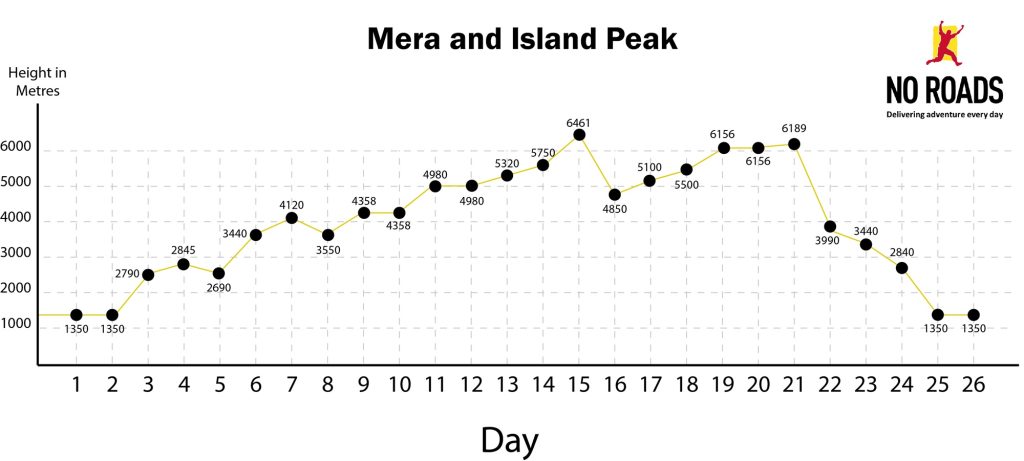
Includes
- Arrival and Departure transfers on both domestic and international flights.
- 3 nights accommodation at Harati Manor Hotel twin share
- OPEN and CHOICE of Full board meals while on expedition.
- One Trekker: One Porter Policy
- Accommodation at clean and comfortable tea houses or lodges.
- Welcome dinner with the cultural program as listed in the itinerary.
- Half-day guided city tour with world heritage entrance permit as listed in the itinerary.
- All Domestic flights and airport tax.
- Private transportation to and from the starting and ending points of the trek as applicable.
- Professional local experienced Trek Leader well trained in Wilderness First Aid with his support crew.
- Experienced Climbing guide with all his allowance and expenses.
- Trekking cook and other support staff while at Island Peak base camp
- Porters to carry all personal gear and group equipment with proper insurance and required gear
- Supplementary Oxygen cylinder regulator or Gamow Bag (A life-saving device in case of Acute Mountain Sickness) along with the comprehensive First Aid Kit.
- All required Personal and Group Climbing gear: LA SPORTIVA climbing boot, EXPED down-filled mattress, Black Diamond crampons, ice axe, Jumar, harness, the figure of eight, Carabiner, climbing Helmet and rope, etc.
- We provide all camping gear including – tents for members, dining tents with tables and backrest chairs, Kitchen tents with utensils, staff, porter, and toilet tents on the whole trip.
- Expedition Gear – sleeping bag, fleece inner liner, down jacket, rain poncho, etc for use during the trip.
- Mera Peak climbing expeditions Permit Royalty of $250USD per person and other government tax.
- Island Peak climbing expeditions Permit Royalty of $250USD per person and other government tax.
- Specialised Climbing Course at base camp.
- Complimentary Trek Duffle bag, and trip map
- Mera Peak and Island Peak climbing certificates issued from the respective body of the Nepal Government for the successful climbers
- Trekking or VDC entry permit, Everest National park entry fees, etc
Excludes
- International flights
- Insurance
- Tips and beverages
Journey Extensions and Upgrades
Check out our Journey Extensions or Add Ons for those that want to stay a little longer or try something different along the way.
In the heart of Thamel, is the Nepali Ghar Hotel. The Nepali Ghar punctuates the new trend of modern hotels and breezes an ode to Nepalese traditional styles. These traditions afford a warm and homely environment for all adventurers. The hotels Delux rooms are luxurious and open with excellent facilities. The hotel has a restaurant that serves great food as well as a fitness centre.
If you would like to stay at the Nepali Ghar Hotel as part of your package of 2 nights before and 1 night after an expedition the extra price will be $600 (for all 3 nights).
For twin rooms where you share the room, the price is $350 per person twin share.
In the heart of Thamel, is the Nepali Ghar Hotel. The Nepali Ghar punctuates the new trend of modern hotels and breezes an ode to Nepalese traditional styles. These traditions afford a warm and homely environment for all adventurers. The hotel’s Delux rooms are luxurious and open with excellent facilities. The hotel has a restaurant that serves great food as well as a fitness centre.
If you would like to stay at the Nepali Ghar Hotel as part of your package of 2 nights before and 1 night after an expedition the extra price will be $350 per person twin share (for all 3 nights).
For single rooms for these nights the extra price is $600.
If you would like to have your own room in Kathmandu we can organise this. The Single Supplement for all Everest Trips is $300 per person. Single rooms are not available outside of Kathmandu.
“High camp was incredible. It was just sheer in every direction, glaciers disappearing straight down into nothing”
Ian – Australia
“We’ve been so looked after by our Sherpa team, they’ve gone beyond expectations I guess. The food, I don’t think we eat this well back home”
Stuart – Australia
Trek responsibly with trained porters and guides
Our team are committed to making sure your journey is a safe and memorable one. Each guest is paired with one porter (we have a 1 Porter 1 Trekker policy) to ensure a comfortable trek, and all of our guides receive medical and mountaineering training to make sure your experience is pleasant. We provide safety equipment and bring necessary medical supplies on each trip.
Prepare for an adventure of a lifetime
Before we begin our trek, our team will review our itinerary to Lukla and answer your questions about what to expect in the days leading to Mera Peak. Our journey to the base camp of Mera Peak will take us on a longer trail first, so we can adjust to the altitude before reaching our high camps. There, our climbing team will be set up and ready for us to learn the skills to climb. Summit day will start before sunrise and we hope to be on the summit to watch the sunrise over the Himalayas. Our return journey is via several more direct and higher altitude passes before we reach Lukla once again.
We get asked a lot of questions about our Mera Peak climb. The following are certainly the most common however if you have another question please let us know or the answer may be found in our Trip Notes section.
How hard is the climb to Mera Peak and Island Peak?
The climb to the summits of Mera Peak & Island Peak is a serious undertaking. While you do not need to have had any climbing experience, you will need to be fit and you will need to be able to handle heights. Several sections crossing the glacier on Mera Peak present crevasses that can be unnerving for some climbers. It can also be very cold with some summit attempts well below zero degrees Celcius. Acclimatisation should be ok as we have several acclimatisation days along the way, but even still, the altitude will hamper normal progress.
We do suggest people who wish to undertake this climb, should have been to an altitude of 5000 metres or higher before, so that they understand the impact this can have on your body.
What about insurance what do I need?
This is one of the most common questions we get. Many insurance policies have activity limits as well as altitude limits. So on top of your general travel insurance that will cover you for the trek to and from the mountain, you will need specialist insurance to cover you for your activities on the mountain.
Global Rescue offers travel insurance without any restrictions on activities, elevation, places travelled, or nationality of its members. Contact them directly for a Travel Insurance Quote that will cover you for climbing. Click here to go to the Global Insurance website for a quote.
Do I have to bring my own climbing equipment?
Of course, if you have your own gear then we encourage you to bring it. However, Mera Peak is usually for those wishing to try climbing for the first time and we understand that purchasing all the equipment is an expensive undertaking.
So we provide the following: a very warm sleeping bag with warm fleece liners and feather duvet jackets which are the mother of all warm clothing. We also provide you with an individual waterproof trek Duffle bag to fit all your gear in.
For climbing we provide La Sportiva climbing boots, Black Diamond crampons, ice axe, ice bar, ice screw, Jumar, harness, the figure of eight, safety Helmet, plain and locking Carabiners, prussic cord and new climbing rope, etc.
We also provide Mountain Hardware 2 member tent, Exped down-filled mattress, and solar lights with a device charging facility. We use solar energy at Island peak base camp.
Note: While this is not always the case, climbing boots that are hired such as our La Sportiva can at times cause blisters, as your foot has not had a chance to adapt to the boots idiosyncracies.
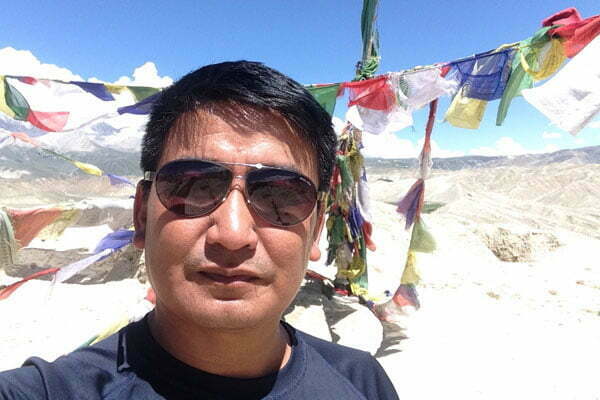
Mera Peak is the highest of the “trekking peaks” but it is often overlooked for more famous “first time” summits such as Island. Mera Peak is an awesome undertaking, away from the main Everest trails and most of the crowds, and from the summit it gives you a great appreciation of the entire Himalaya. Mera Peak offers enough technical climbing to give you a great first experience of what mountaineering is all about. I am sure Mera Peak will make you want to come back for more.
Pradip
Nepal Ops Manager


